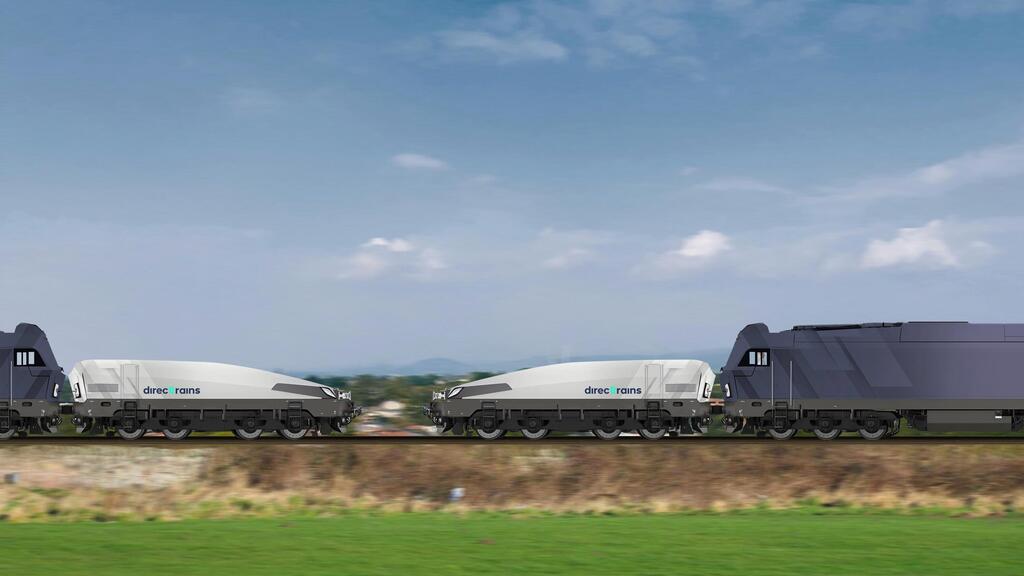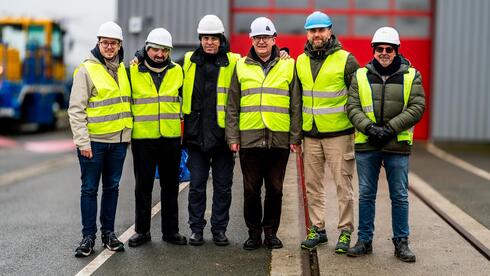
All aboard: The Israeli startup promising smarter, greener rail logistics
DirecTrainS’ in-motion coupling system promises to revolutionize rail capacity without overhauling existing infrastructure. As deployment in key markets near, the Israeli startup could be on track to change how the world moves.
On a test track in France, a quiet revolution in rail transport has taken its first major step toward reshaping how goods, and eventually passengers, move around the world.
Israeli startup DirecTrainS recently completed its first full-scale field test of a technology that could challenge the way we think about rail freight.
The company’s pioneering Dynamic Coupling (DC) system allows trains to couple and decouple while in motion, a feat the team claims can increase line capacity by 40 percent without laying a single new meter of track. Conducted on a live railway line in partnership with French engineering company CERTIA, the system’s real-world test, according to CEO Alberto Mandler, “demonstrates that our vision for transforming rail transport is becoming reality.”
“It proved the concept,” CTO Moti Topf told CTech. The DC system includes a specialized wagon and an accompanying software platform that maps and manages coupling points. During the recent test, full-size 22.5-ton carts were used to validate the system’s smoothness and stability, even passing the ‘water cup test,’ with not a drop spilled from a cup placed on the fixture during coupling.
Incorporated in Israel in 2021, with offices in Tel Aviv and Zichron Yaakov, DirecTrainS is unique in its foundation: a company built on aerospace-grade thinking. With the majority of its founding team hailing from an aerospace background, they bring high-flying ideas to an industry known for its conservatism – a distinction that has helped steer the company off the beaten track.
“None of us is really from the rail industry,” said Topf, a mechanical engineer and veteran of the Israel Air Force and its aerospace programs, who now serves as DirecTrainS’ rolling stock systems engineer. “Most of my experience from the Air Force is huge, multidisciplinary program management – programs that are not only focused on mechanics.”
Alberto Mandler, also an aerospace engineer, is a second-time founder. His previous startup, Centipede, is an IP provider specializing in high-end processors for the semiconductor industry.
VP of Marketing, Leah Mandler, meanwhile, comes from a background in political science and environmental policy. She believes there’s strength in cross-industry thinking: “I think that our diverse backgrounds and the fact that we did not grow within the railway industry are a huge advantage.
“We are able to create this huge leap forward exactly because we're not coming from the railway industry.”
While their backgrounds afforded them the perspective to lay fresh eyes on an old system, Alberto admitted that their original idea to provide “a direct service from anywhere to anywhere” proved too ambitious and needed, quite literally, to be grounded.
“We realized that it is too futuristic, so we need to take it down to ground, to Earth,” said Alberto. The realization led the team to develop their plug-and-play coupling solution that requires no changes to existing rail infrastructure: “No regulation changes, no changes in the train, no changes anywhere.”
The lack of required changes is key to the system’s viability, said Alberto, who explained that reducing friction to enter the market had to be a priority. Piggybacking off existing infrastructure has also shaped DirecTrainS’ go-to-market strategy: positioning itself as a Hardware-as-a-Service (HaaS) provider, offering renewable annual software licenses per wagon. The initial use case focuses on enabling middle-mile parcel delivery by rail. Eventually, the team believes the same approach could revolutionise passenger transport as well.
“We thought about all the parcels coming into the city on big trucks and creating congestion, pollution and everything that you see on your way to work every day we're stuck in traffic,” said Leah.
While trains offer a greener alternative to road freight, the problem is that many lines are already operating at full capacity, with no room to add more services. The only way to increase throughput, the team realized, was to find a way for trains to safely run closer together.
Related articles:
“We realized that if we are able to combine them and then release them dynamically while they are driving… then we could insert into the time frame many more trains than we have today,” added Leah.
Today, DirecTrainS is a five-person team (plus one temporary student), operating at TRL 7 (Technology Readiness Level) with two patents issued. Over the next 18 months, the company aims to reach TRL 8 by ramping up real-world demonstrations and proving the system’s compatibility with different signaling environments and rolling stock configurations.
Having bootstrapped around $1 million to date, the founders are now raising a $4.4 million Seed round to support further development and planned field testing. This next phase will also involve finalizing the prototype, expanding their consortium, and pilot testing with parcel delivery companies and railway operators, with the U.S. and Europe as their first “main targets,” according to Alberto.
The team sees a significant opportunity for their product to relieve congestion and realize untapped rail capacity in these markets, especially compared to EU-led programs like virtual coupling and moving blocks, which aim to achieve the same feat, albeit less efficiently.
“Both require an immense cost to replace,” noted Alberto. “They need to replace what is called a signaling system… Only after you do the entire change of the entire network with all the locomotives being adapted, only then you will start gaining from it. We want something much faster to adopt.”
Closer to home, the team conducted an internal analysis of Israel’s Haifa–Tel Aviv line and found that, “with the existing infrastructure, we could quadruple the amount of trains that are coming from Haifa to Tel Aviv,” Alberto said. “We can double the overall capacity of the line.”
Now, with proof of concept in hand, DirecTrainS is moving full steam ahead in pursuit of a rather lofty mission.
“We will make people go by train instead of cars,” stated Alberto. “We will reduce the number of cars. And the side effect of it will be enormous, not only for the companies that are taking our technology, but also for the world. And this is, this is the direction that we want to go.”
Company Name: DirecTrainS
Sector: Rail Technology, Transportation Technology, Logistics Technology, Smart Cities
Product/Service description: Dynamic train coupling technology that enables trains/cars to couple and decouple while in motion (at speed). DirecTrainS operates as a HaaS (Hardware-as-a-Service) business model with renewable annual software licensing per DC wagon.
Offices location: Tel Aviv and Zichron Yaakov, Israel
Last Investment Round: $1M (self-funded)
Last Investment Stage: Seed stage (currently raising $4.4M seed round)
Date of Last Investment: N/A
Total investment to date: Around $1M (self-funded by founders and team members)
Investors: Bootstrapped (founder-funded)
Current number of employees: 5 (plus one temporary, foreign student)
Open positions: None right now (until after the investment)
Development Stage: TRL 6-7 (functional prototype stage)
“None of us is really from the rail industry,” said Topf, a mechanical engineer and veteran of the Israel Air Force and its aerospace programs, who now serves as DirecTrainS’ rolling stock systems engineer. “Most of my experience from the Air Force is huge, multidisciplinary program management – programs that are not only focused on mechanics.”
Alberto Mandler, also an aerospace engineer, is a second-time founder. His previous startup, Centipede, is an IP provider specializing in high-end processors for the semiconductor industry.
VP of Marketing, Leah Mandler, meanwhile, comes from a background in political science and environmental policy. She believes there’s strength in cross-industry thinking: “I think that our diverse backgrounds and the fact that we did not grow within the railway industry are a huge advantage.
“We are able to create this huge leap forward exactly because we're not coming from the railway industry.”
While their backgrounds afforded them the perspective to lay fresh eyes on an old system, Alberto admitted that their original idea to provide “a direct service from anywhere to anywhere” proved too ambitious and needed, quite literally, to be grounded.
“We realized that it is too futuristic, so we need to take it down to ground, to Earth,” said Alberto. The realization led the team to develop their plug-and-play coupling solution that requires no changes to existing rail infrastructure: “No regulation changes, no changes in the train, no changes anywhere.”
The lack of required changes is key to the system’s viability, said Alberto, who explained that reducing friction to enter the market had to be a priority. Piggybacking off existing infrastructure has also shaped DirecTrainS’ go-to-market strategy: positioning itself as a Hardware-as-a-Service (HaaS) provider, offering renewable annual software licenses per wagon. The initial use case focuses on enabling middle-mile parcel delivery by rail. Eventually, the team believes the same approach could revolutionise passenger transport as well.
“We thought about all the parcels coming into the city on big trucks and creating congestion, pollution and everything that you see on your way to work every day we're stuck in traffic,” said Leah.
While trains offer a greener alternative to road freight, the problem is that many lines are already operating at full capacity, with no room to add more services. The only way to increase throughput, the team realized, was to find a way for trains to safely run closer together.
Related articles:
“We realized that if we are able to combine them and then release them dynamically while they are driving… then we could insert into the time frame many more trains than we have today,” added Leah.
Today, DirecTrainS is a five-person team (plus one temporary student), operating at TRL 7 (Technology Readiness Level) with two patents issued. Over the next 18 months, the company aims to reach TRL 8 by ramping up real-world demonstrations and proving the system’s compatibility with different signaling environments and rolling stock configurations.
Having bootstrapped around $1 million to date, the founders are now raising a $4.4 million Seed round to support further development and planned field testing. This next phase will also involve finalizing the prototype, expanding their consortium, and pilot testing with parcel delivery companies and railway operators, with the U.S. and Europe as their first “main targets,” according to Alberto.
The team sees a significant opportunity for their product to relieve congestion and realize untapped rail capacity in these markets, especially compared to EU-led programs like virtual coupling and moving blocks, which aim to achieve the same feat, albeit less efficiently.
“Both require an immense cost to replace,” noted Alberto. “They need to replace what is called a signaling system… Only after you do the entire change of the entire network with all the locomotives being adapted, only then you will start gaining from it. We want something much faster to adopt.”
Closer to home, the team conducted an internal analysis of Israel’s Haifa–Tel Aviv line and found that, “with the existing infrastructure, we could quadruple the amount of trains that are coming from Haifa to Tel Aviv,” Alberto said. “We can double the overall capacity of the line.”
Now, with proof of concept in hand, DirecTrainS is moving full steam ahead in pursuit of a rather lofty mission.
“We will make people go by train instead of cars,” stated Alberto. “We will reduce the number of cars. And the side effect of it will be enormous, not only for the companies that are taking our technology, but also for the world. And this is, this is the direction that we want to go.”
Company Name: DirecTrainS
Sector: Rail Technology, Transportation Technology, Logistics Technology, Smart Cities
Product/Service description: Dynamic train coupling technology that enables trains/cars to couple and decouple while in motion (at speed). DirecTrainS operates as a HaaS (Hardware-as-a-Service) business model with renewable annual software licensing per DC wagon.
Offices location: Tel Aviv and Zichron Yaakov, Israel
Last Investment Round: $1M (self-funded)
Last Investment Stage: Seed stage (currently raising $4.4M seed round)
Date of Last Investment: N/A
Total investment to date: Around $1M (self-funded by founders and team members)
Investors: Bootstrapped (founder-funded)
Current number of employees: 5 (plus one temporary, foreign student)
Open positions: None right now (until after the investment)
Development Stage: TRL 6-7 (functional prototype stage)


